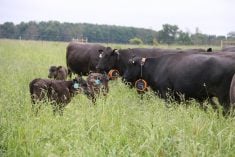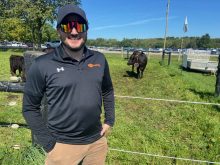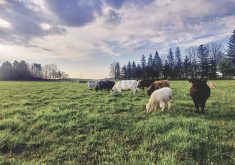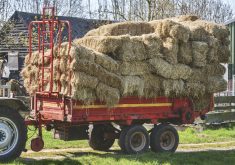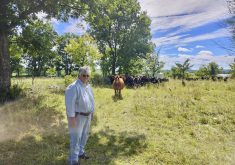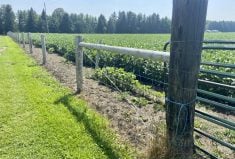A team of researchers aims to fine-tune recommendations for rotational grazing in Ontario and a key piece of that research is a tool called a rising plate meter.
Ontario Ministry of Agriculture, Food and Rural Affairs (OMAFRA) forage and grazing specialist Christine O’Reilly outlined use of the rising plate meter during a plot tour Sept. 8 at one of the farms hosting the research.
At the Groot family’s Wholesome Pastures near Crediton, a series of one-acre strips being cropped as part of the federal-provincial Living Labs soil health program includes replications of a pasture mix that was rotationally grazed over three years.
Read Also

Jennifer Hayes appointed for second term as the Chairperson of the Canadian Dairy Commission
Jennifer Hayes has been re-appointed as Chairperson of the Canadian Dairy Commission by Heath MacDonald, Minister of Agriculture and Agri-Food.
Why it matters: Accurately tracking nutrient content and stocking potential will help farmers take advantage of climate change mitigation-related government grant programs for fencing and pasture.
“I can measure this pasture as fast as I can walk it,” O’Reilly said as she walked through one of the test strips. She repeatedly dropped the hand-held plate meter to the ground, like a walking stick, and used her thumb to click on the tool every time it touched the ground.
A plate loosely attached to the walking stick rose and fell due to the application and removal of pressure from grass being compressed under the plate.
From the data collected, O’Reilly said users can determine the “average compressed pasture per acre” and use a formula to calculate dry matter available. This can inform pasture decisions like stocking rate, timing for return to that paddock, or whether to preserve second-cut hayfield vitality by using a “summer slump.”
O’Reilly said recent research in New Zealand showed farmers who use rising plate meter data in their decision-making made $150 to $200 more per acre, on average, than those who didn’t use it.
But she also noted that the weather in New Zealand, or even Western Canada, is markedly different from the hot, humid and sometimes rainy summers of southern Ontario. However, farmers doing online searches for rotational grazing insight typically find themselves reading about research conducted in those drier, cooler locales.
One commonly repeated rule of thumb is to let livestock take half of the available pasture before moving to the next paddock.
“Especially in our tame (grass) species, I think we’re leaving money on the table if we leave half,” O’Reilly said.
In southern Ontario generally, pastures can be grazed more aggressively and still have ample heat, sunlight and moisture to recover in time for a second or third pass through a paddock.
In Ireland, recommendations have been fine-tuned to reflect the island’s rainfall. Researchers settled on 85 per cent utilization in dairy cattle and 60 per cent utilization in sheep.
In Ontario, summer weather is hotter and more humid than in Ireland. O’Reilly hopes that through a collaboration with OMAFRA beef cattle specialist James Byrne and plant agriculture assistant professor Kim Schneider at the University of Guelph, recommendations will be available that are more suited to the Ontario climate.
Courtney Higgins, a Master’s student working with Schneider, has been collecting plate meter data from Wholesome Pastures, the Ontario Beef Research Station at Elora, the Victoria County Community Pasture near Hartley and the Alfred College research farm in eastern Ontario.
“Courtney is pairing rising plate meter readings in centimetres of compressed sward height with clipped grass samples in kilograms of dry matter per hectare,” O’Reilly told Farmtario. “She is testing whether we need different equations for different regions in the province, and when we need to switch between different equations throughout the growing season.”
Once Ontario equations are determined, the plan is to gather a group of producers and provide them with rising plate meters.
“The group will meet regularly throughout the grazing season to talk about grass management and using the plate meter. Ideally, there will be a lot of farmer-to-farmer learning going on, especially once they can benchmark themselves against others in the group, since they’ll all be bringing grass production data to the meetings.”
The meters work well with vegetative grasses and clover but the plate won’t generally compress the pasture if it has significant coarse-stemmed alfalfa.
For alfalfa, a more effective way to assess dry matter quantity and quality is the PEAQ (Predictive Equations for Alfalfa Quality) method. This involves measuring the height of the highest plant in the stand and combining that in an equation with an estimate of the stage of maturity in the most well-developed plant in the stand.




